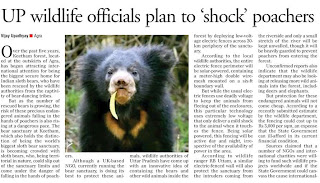UP wildlife officials plan to ‘shock’ poachers
Vijay Upadhyay | Agra
Over the past five years, Keetham forest, located at the outskirts of Agra, has begun attracting international attention for being the biggest secure home for Indian sloth bears, who have been rescued by the wildlife authorities from the captivity of bear-dancing tribes.
But as the number of rescued bears is growing, the risk of these precious endangered animals falling in the hands of poachers is also rising at a dangerous pace. The bear sanctuary at Keetham, which also holds the distinction of being the world's biggest sloth bear sanctuary, is becoming crowded with sloth bears, who, being territorial in nature, could slip out of the sanctuary limits and come under the danger of falling in the hands of poachers.
The bear sanctuary at Keetham, which also holds the distinction of being the world's biggest sloth bear sanctuary, is becoming crowded with sloth bears, who, being territorial in nature, could slip out of the sanctuary limits and come under the danger of falling in the hands of poachers.
Although a UK-based NGO, currently running the bear sanctuary, is doing its best to protect these animals, wildlife authorities of Uttar Pradesh have come up with an innovative idea of containing the bears and other wild animals inside the forest by deploying low-voltage electric fences across 20-km periphery of the sanctuary.

According to the local wildlife authorities, the entire electric fence perimeter will be solar-powered, containing a meter-high double wire-mesh mounted on a six-ft boundary wall.
But while the usual electric fences use deadly voltage to keep the animals from fleeing out of the enclosures, this particular technology uses extremely low voltage that only deliver a mild shock to the animal when it touches the fence. Being solar powered, this fencing will be active day and night, irrespective of the availability of power in the area.
According to wildlife ranger RB Uttam, a similar electric-fenced wall will also protect the sanctuary from the intruders coming from the riverside and only a small stretch of the river will be kept unwalled, though it will be heavily guarded to prevent poachers from entering the forest.
Unconfirmed reports also indicate that the wildlife department may also be looking at releasing more wild animals into the forest, including deers and elephants.
But protection for these endangered animals will not come cheap. According to a recently submitted estimate by the wildlife department, the fencing could cost up to Rs 3,000 per sqm, an expense that the State Government can ill-afford in its current financial condition.
Sources claimed that a number of NGOs and international charities were willing to fund such wildlife projects worldwide and if the State Government could canvass the cause internationally, the project could take off soon.
Over the past five years, Keetham forest, located at the outskirts of Agra, has begun attracting international attention for being the biggest secure home for Indian sloth bears, who have been rescued by the wildlife authorities from the captivity of bear-dancing tribes.
But as the number of rescued bears is growing, the risk of these precious endangered animals falling in the hands of poachers is also rising at a dangerous pace.
 The bear sanctuary at Keetham, which also holds the distinction of being the world's biggest sloth bear sanctuary, is becoming crowded with sloth bears, who, being territorial in nature, could slip out of the sanctuary limits and come under the danger of falling in the hands of poachers.
The bear sanctuary at Keetham, which also holds the distinction of being the world's biggest sloth bear sanctuary, is becoming crowded with sloth bears, who, being territorial in nature, could slip out of the sanctuary limits and come under the danger of falling in the hands of poachers. Although a UK-based NGO, currently running the bear sanctuary, is doing its best to protect these animals, wildlife authorities of Uttar Pradesh have come up with an innovative idea of containing the bears and other wild animals inside the forest by deploying low-voltage electric fences across 20-km periphery of the sanctuary.

According to the local wildlife authorities, the entire electric fence perimeter will be solar-powered, containing a meter-high double wire-mesh mounted on a six-ft boundary wall.
But while the usual electric fences use deadly voltage to keep the animals from fleeing out of the enclosures, this particular technology uses extremely low voltage that only deliver a mild shock to the animal when it touches the fence. Being solar powered, this fencing will be active day and night, irrespective of the availability of power in the area.
According to wildlife ranger RB Uttam, a similar electric-fenced wall will also protect the sanctuary from the intruders coming from the riverside and only a small stretch of the river will be kept unwalled, though it will be heavily guarded to prevent poachers from entering the forest.
Unconfirmed reports also indicate that the wildlife department may also be looking at releasing more wild animals into the forest, including deers and elephants.
But protection for these endangered animals will not come cheap. According to a recently submitted estimate by the wildlife department, the fencing could cost up to Rs 3,000 per sqm, an expense that the State Government can ill-afford in its current financial condition.
Sources claimed that a number of NGOs and international charities were willing to fund such wildlife projects worldwide and if the State Government could canvass the cause internationally, the project could take off soon.

Comments